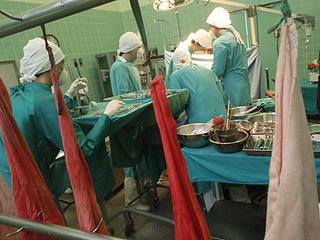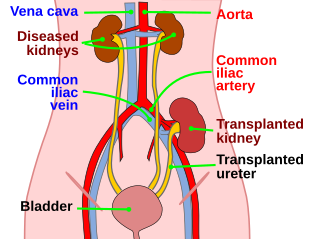
Organ donation is the process when a person allows an organ of their own to be removed and transplanted to another person, legally, either by consent while the donor is alive or dead with the assent of the next of kin.

Organ transplantation is a medical procedure in which an organ is removed from one body and placed in the body of a recipient, to replace a damaged or missing organ. The donor and recipient may be at the same location, or organs may be transported from a donor site to another location. Organs and/or tissues that are transplanted within the same person's body are called autografts. Transplants that are recently performed between two subjects of the same species are called allografts. Allografts can either be from a living or cadaveric source.
Brain death is the permanent, irreversible, and complete loss of brain function which may include cessation of involuntary activity necessary to sustain life. It differs from persistent vegetative state, in which the person is alive and some autonomic functions remain. It is also distinct from comas as long as some brain and bodily activity and function remain, and it is also not the same as the condition locked-in syndrome. A differential diagnosis can medically distinguish these differing conditions.
Apnea, BrE: apnoea, is the temporal cessation of breathing. During apnea, there is no movement of the muscles of inhalation, and the volume of the lungs initially remains unchanged. Depending on how blocked the airways are, there may or may not be a flow of gas between the lungs and the environment. If there is sufficient flow, gas exchange within the lungs and cellular respiration would not be severely affected. Voluntarily doing this is called holding one's breath. Apnea may first be diagnosed in childhood, and it is recommended to consult an ENT specialist, allergist or sleep physician to discuss symptoms when noticed; malformation and/or malfunctioning of the upper airways may be observed by an orthodontist.
Prior to the introduction of brain death into law in the mid to late 1970s, all organ transplants from cadaveric donors came from non-heart-beating donors (NHBDs).

Kidney transplant or renal transplant is the organ transplant of a kidney into a patient with end-stage kidney disease (ESRD). Kidney transplant is typically classified as deceased-donor or living-donor transplantation depending on the source of the donor organ. Living-donor kidney transplants are further characterized as genetically related (living-related) or non-related (living-unrelated) transplants, depending on whether a biological relationship exists between the donor and recipient.
A flatline is an electrical time sequence measurement that shows no activity and therefore, when represented, shows a flat line instead of a moving one. It almost always refers to either a flatlined electrocardiogram, where the heart shows no electrical activity (asystole), or to a flat electroencephalogram, in which the brain shows no electrical activity. Both of these specific cases are involved in various definitions of death.

Lung transplantation, or pulmonary transplantation, is a surgical procedure in which one or both lungs are replaced by lungs from a donor. Donor lungs can be retrieved from a living or deceased donor. A living donor can only donate one lung lobe. With some lung diseases, a recipient may only need to receive a single lung. With other lung diseases such as cystic fibrosis, it is imperative that a recipient receive two lungs. While lung transplants carry certain associated risks, they can also extend life expectancy and enhance the quality of life for those with end stage pulmonary disease.
Organ procurement is a surgical procedure that removes organs or tissues for reuse, typically for organ transplantation.
Certain fundamental Jewish law questions arise in issues of organ donation. Donation of an organ from a living person to save another's life, where the donor's health will not appreciably suffer, is permitted and encouraged in Jewish law. Donation of an organ from a dead person is equally permitted for the same purpose: to save a life. This simple statement of the issue belies, however, the complexity of defining death in Jewish law. Thus, although there are side issues regarding mutilation of the body etc., the primary issue that prevents organ donation from the dead amongst Jews, in many cases, is the definition of death, simply because to take a life-sustaining organ from a person who was still alive would be murder.
Transplantable organs and tissues may refer to both organs and tissues that are relatively often transplanted, as well as organs and tissues which are relatively seldom transplanted. In addition to this it may also refer to possible-transplants which are still in the experimental stage.
The Lazarus sign or Lazarus reflex is a reflex movement in brain-dead or brainstem failure patients, which causes them to briefly raise their arms and drop them crossed on their chests. The phenomenon is named after the Biblical figure Lazarus of Bethany, whom Jesus raised from the dead according to the Gospel of John.
Many different major religious groups and denominations have varying views on organ donation of a deceased and live bodies, depending on their ideologies. Differing opinions can arise depending on if the death is categorized as brain death or cease of the heartbeat. It is important for doctors and health care providers to be knowledgeable about differentiating theological and cultural views on death and organ donations as nations are becoming more multicultural.
Organ transplantation in Japan is regulated by the 1997 Organ Transplant Law which legalized organ procurement from "brain dead" donors. After an early involvement in organ transplantation that was on a par with developments in the rest of the world, attitudes in Japan altered after a transplant by Dr. Wada in 1968 failed, and a subsequent ban on cadaveric organ donation lasted 30 years. The first transplant after the Organ Transplant Law had defined "brain death" took place in February 1999.
Brainstem death is a clinical syndrome defined by the absence of reflexes with pathways through the brainstem – the "stalk" of the brain, which connects the spinal cord to the mid-brain, cerebellum and cerebral hemispheres – in a deeply comatose, ventilator-dependent patient. Identification of this state carries a very grave prognosis for survival; cessation of heartbeat often occurs within a few days, although it may continue for weeks if intensive support is maintained.
Legal death is the recognition under the law of a particular jurisdiction that a person is no longer alive. In most cases, a doctor's declaration of death or the identification of a corpse is a legal requirement for such recognition. A person who has been missing for a sufficiently long period of time may be presumed or declared legally dead, usually by a court. When a death has been registered in a civil registry, a death certificate may be issued. Such death certificate may be required in a number of legal situations, such as applying for probate, claiming some benefits, or making an insurance claim.
Organ donation is when a person gives their organs after they die to someone in need of new organs. Transplantation is the process of transplanting the organs donated into another person. This process extends the life expectancy of a person suffering from organ failure. The number of patients requiring organ transplants outweighs the number of donor organs available.
The current law in Ireland requires the potential donor to opt in to becoming an organ donor. However, it is ultimately up to their family to make the decision whether or not the person is allowed to donate their organs after they die.
Organ transplantation in the Indian state of Tamil Nadu is regulated by India's Transplantation of Human Organs Act, 1994 and is facilitated by the Transplant Authority of Tamil Nadu (TRANSTAN) of the Government of Tamil Nadu and several NGOs. Tamil Nadu ranks first in India in deceased organ donation rate at 1.8 per million population, which is seven times higher than the national average.
Organ donation in India is regulated by the Transplantation of Human Organs and Tissues Act, 1994. The law allows both deceased and living donors to donate their organs. It also identifies brain death as a form of death. The National Organ and Tissue Transplant Organisation (NOTTO) functions as the apex body for activities of relating to procurement, allotment and distribution of organs in the country.



